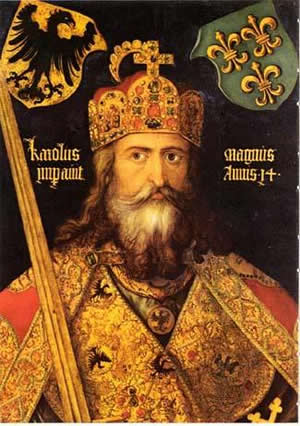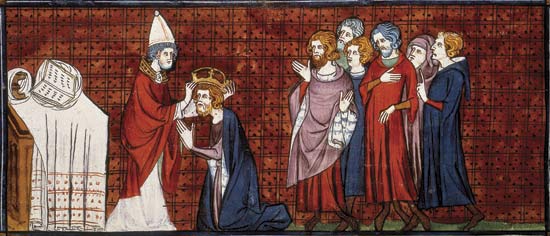The Carolingian Renaissance
The first years of Charlemagne’s rule were focused on expanding the Frankish kingdom. He invaded Saxony, the Lombard territories and northern Spain (at the time controlled by the Moors). In 780 he headed further north, occupying Bohemia and the central Danube Basin.
Charlemagne was the esldest son of Pepin III. Also called Pepin the Short, he was a powereful higher official in the Merovingian court (from the Germanic tribe the Francs).
Pippin, Peppin, and Pepin (Latin: Pippinus, Pipinus, and Pepinus) are one and the same.
With Pope Stephen II's benediction Pepin seized the throne from Childeric III and in 768 became King of the Francs. Pepin promised to protect Rome from attacks and in 755 successfully pushed back the Lombards. He offered the Pope territories in central Italy that the pontificat titled the "Papal States".
Pepin III was succeeded by his sons Charlemagne and Carloman, who did not get along. Carloman was not apt militarily and could not be counted on. Charlemagne enlisted the help of Desiderius, king of the Lombards, to overthrow his brother. To seal the agreement he married the king's daughter.
Charlemagne
German king born in 747, also called Charles I, Charles the Great, Carolus Magnus, and Karl der Grosse

This relationship with the Lombards tested his deceased father's reputation with the Vatican, but the alliance didn't last long. Charlemagne reputed his wife (the name is uncertain but she is generally called Desiderata) most likely because she could bear him no children. Humiliated, her father sided with Carloman but the matter was put to rest when Carloman died suddenly, apparently of natural causes. Charlemagne had altogether four wives, five known concubines and eighteen children. He was a family man and took part in his childrens education but he would not allow them to have an opinion.

In 800 a plot was set for Pope Leo III to abdicate, and Charlemagne went to Rome to help keep him in power.
In return for the favor he was crowned the first "Holy Roman Emperor" in the pope's Holy Roman Empire.
Charlemagne structured his government with representatives in each region and held yearly general assemblies. He initiated administrative and legal reforms, and helped improve commerce by standardizing weights and measures. He invited scholars to his court, enticing them with an extensive library of classic Greek and Christian books.
His sons participated at an early age in the affairs of the kingdom and he had two of them crowned well in advance, under the auspices of the pope, to insure a direct succession to his kingdom. He placed heavy restrictions on his daughters and would not relinquish authority to his sons; there was no conversation and any show of discontent was punished. His son Pepin joined a revolution and was banished. Altogether there were eight Pepin (Peppin, Pippin) in the family, including a second son born Carloman but later called Pepin. Whatever.
His empire encompassed a great part of Western Europe where he masterminded the cultural and intellectual revival in literature, art, and architecture. He also subsidized monastic schools and scriptoria (book-making schools) to ensure the survival of Christianity in the western world.
He died in 814 after having ruled as Emperor for just over thirteen years.His dynasty did not last long after.